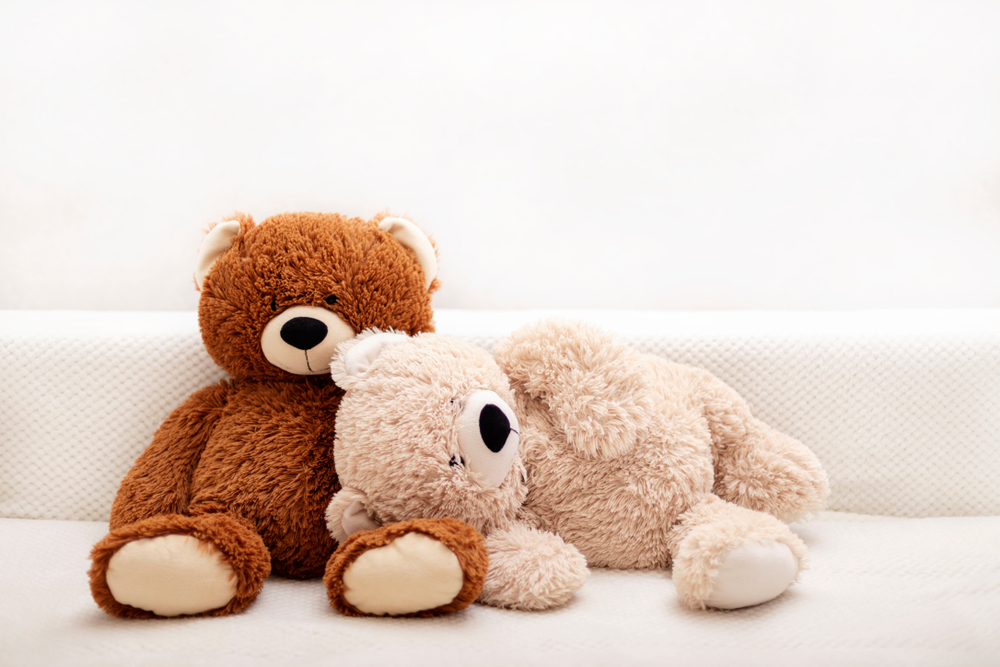Adults who still sleep with their ancient teddy bears or plush puppies are often accused of clinging to childhood comforts and refusing to grow up. But a new U.K. survey of 2,000 adults by the home appliance company Hotpoint reports that a third of adults polled (of both genders) still sleep with stuffed animals. What’s even more fascinating, one in 10 people would rather sleep with their beloved toy than with a partner, the poll reported.
Thrive explored whether stuffed toys — and other comfort objects like weighted blankets and body pillows — can truly help adults sleep better. It turns out that taking those well-worn toys to bed can be a good idea, no matter how old you are.
Stuffed animals
So far, there hasn’t been a major scientific study on the topic, but many psychologists agree that tactile contact with an inanimate comfort object can be beneficial. In 2013, research by V.U. University Amsterdam found that soft toys lower stress levels and promote a good night’s sleep.
The research adds weight to the Scandinavian Hygge trend, with its focus on the power of deep comfort. “Teddy bears and blankets can be useful because sleep is a time for relaxation,” Philip R. Gehrman, Ph.D., an associate professor of psychology at the University of Pennsylvania, tells Thrive. “Parents are told that it’s good to build a bedtime routine for children, reading books and taking stuffed animals to bed. These transitional objects are associated with sleep and give off cues triggering sleep — and that applies to adults, too,” Gehrman says.
An attachment to plush toys is understandable from an evolutionary standpoint, according to Katherine Duggan, Ph.D., a psychologist in the Department of Psychiatry at the University of Pittsburgh. “Most theories of sleep assume that you have to feel trust and safety in your environment. Sleep is a vulnerable state. You’re disconnecting from the world, and children need a sense of security in order to disengage. Sometimes, that security can come from direct contact — when children are co-sleeping with parents. But at other times, that sense of safety may come from transitional objects, like bears or blankets.”
As adults, Duggan says, those objects continue to be associated with soothing emotions. “In the behavioral sleep medicine world, we talk about repeatedly pairing experiences with sleep. So we tell poor sleepers to avoid reading, watching TV, and using their phone in bed, because they are going to associate their beds with those behaviors, instead of sleep. If you’ve paired a teddy bear with sleep as a child, as an adult you may feel like it can help you sleep as well.”
For Alison Chapman, a book editor from Oxfordshire in the U.K., sleeping with her entire family of bunnies (along with her partner) is essential. “A few years ago, I had been suffering from poor sleep and didn’t want to resort to medication,” Chapman tells Thrive. “Observing how my teenage daughter slept with her favorite childhood stuffed dog, I thought: If soft toys soothe children, why should it be different for adults? So Mr. B.B., my soft bunny, came to bed with me and the experiment immediately worked. My partner, Paul, accepted that we were now going to be three in the bed! Three other bunnies joined the family and now ‘the Boyz’ snuggle down between us each night.”
“Ali loves soft toys so I grew to love them, too,” says Chapman’s partner, Paul Miller, CEO of The Digital Workplace Group, a global strategic partnership and consulting firm. “Ali and I have given the Boyz well-defined personalities and we have lots of laughter as we put words in their mouths. The Boyz definitely help us to fall asleep happily.”
Weighted blankets
If you’re not inclined to sleep with a bear or bunny, another option is a weighted blanket. Filled with beads or pellets to make it heavier, the idea is that it acts like swaddling, which has a calming effect on babies.
Originally used in therapy settings for patients with autism and sensory processing issues, weighted blankets have gone mainstream, with millions of people responding to the sensation of feeling grounded and enveloped, which many say helps them sleep.
Why does this pressure work? “We are probably programed to respond to the feeling of pressure from infancy,” Christoher Winter, M.D., Director of the Charlottesville Neurology and Sleep Medicine Center in Charlottesville, Virginia, tells Thrive. “So when an adult is upset, we put our arms around them and squeeze them. It’s likely that there is a deep-seated reflex and we respond to that tightening and pressure, as babies and adults. The pressure from the blankets can make us more relaxed and secure,” says Winter, author of The Sleep Solution: Why Your Sleep Is Broken and How To Fix It.
“We keep one in our clinic for people who are struggling with their sleep, particularly patients with restless leg syndrome,” he says. “It’s amazing how many people respond well to them. We’ve sent them to sports teams we work with too.”
Body pillows
Another option to ease you into a good night’s sleep is a long body pillow. “They can help by supporting the body orthopedically, but also in terms of maintaining a certain position during the night,” says Winter. “If you have your arms around the pillow, holding it at the top, and you keep it between your legs, it could help to align your spine properly. Without it, your higher leg can start to droop, which changes your pelvic and lower spine orientation,” he explains.
“There’s something deep seated in us that finds snuggling or ‘spooning’ a body pillow comforting,” Winter tells Thrive. “Pregnant women often use them to stay positioned on their side in bed, giving them something for the abdomen to rest on, which can be more comfortable.” And they’re useful for people struggling with snoring, too. Keeping a body pillow behind you acts as a blockade to prevent you from rolling onto your back. Often, people snore when sleeping on their back, but not on their side.”
“My wife started using a body pillow during her second pregnancy and never gave it up,” says the University of Pennsylvania’s Gehrman. “She enjoys it, and if there are objects that are meaningful and comforting to people, whether they are bears, blankets, or body pillows, then logically those will help them sleep.”
While each of these comfort objects may not work for everyone, they can be helpful for many. As for stuffed animals being juvenile? “I’d rather be juvenile and asleep,” says Gehrman, “than awake and mature.”
Follow us here and subscribe here for all the latest news on how you can keep Thriving.
Stay up to date or catch-up on all our podcasts with Arianna Huffington here.


